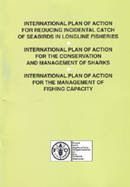Publications
Inland fisheries differ from most other fisheries forming the subject of the Code in their high degree of inter-relatedness with other users of the aquatic resource. In most areas of the world the principal impacts on fisheries do not originate from the fishery itself but from outside the fishery.
Consequently most aspects of the Code directed at the conservation and sustainability of the resource are under the control of a wide range of interests of...
The IPOA-SEABIRDS is a voluntary instrument that applies to all States whose fishermen engage in longline fisheries. The text sets out a set of activities which implementing States are expected to carry out, including an assessment of whether a problem exists with respect to the incidental catch of seabirds in its longline fishery, adopting a National Plan of Action for reducing the incidental catch of seabirds in longline fisheries (NPOA-SEABIRDS) as well as procedures for national reviews...
These guidelines have been produced to support the implementation of the Code of Conduct for Responsible Fisheries. They relate mainly to Article 7 (Fisheries Management) but also to Articles 6 (General Principles), 8 (Fishing Operations), 10 (Integration of Fisheries into Coastal Area Management), 11 (Post-Harvest Practices and Trade) and 12 (Research). As for the other guidelines, they are addressed primarily to the decision-makers and policy-makers in marine capture fisheries, but should also be useful to...
These guidelines have been produced to support the implementation of the Code of Conduct for Responsible Fisheries particularly with regard to the need for responsibility in the post-harvest sector of the fish producing industry.
The industry that produces fish for food has three major areas of responsibility:
to the consumer of the food to ensure that it is safe to eat, is of expected quality and nutritional value,
to the resource to ensure that it is not wasted...
These Guidelines have been produced to support the implementation of Article 7 of the Code of Conduct for Responsible Fisheries, with some reference to Article 12. They are addressed primarily to the decision-makers within fisheries management authorities and other interest groups, including fishing companies, fishers' organizations, concerned non-governmental organizations and others. The Guidelines provide a background to the need for fisheries management and an introduction to the activities encompassed by fisheries management.
They introduce the major...






